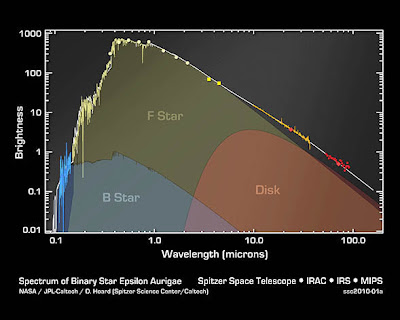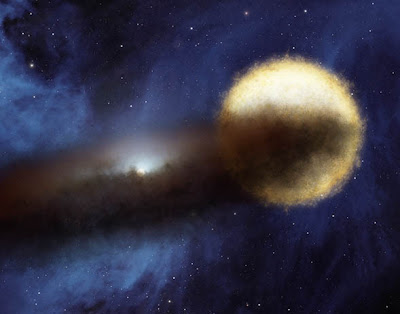 Using an instrument created at the University of Michigan, astronomers have for the first time imaged a peculiar binary star eclipse that happens once every 27 years. Click here for more information.
Using an instrument created at the University of Michigan, astronomers have for the first time imaged a peculiar binary star eclipse that happens once every 27 years. Click here for more information.ANN ARBOR, Mich.---For the first time, astronomers have directly observed the mysterious dark companion in a binary star system that has puzzled skywatchers since the 19th century.
Using an instrument developed at the University of Michigan, scientists have taken close-up pictures of Epsilon Aurigae during its eclipse, which happens every 27 years. "Close up" in this case is a relative term, but the images zoom in enough to show the shape of the dark object's shadow.
"Seeing is believing," said John Monnier, an associate professor in the U-M Department of Astronomy who is an author of a paper about the research findings published in the April 8 edition of Nature. Researchers from the University of Denver and Georgia State University were involved as well.
Epsilon Aurigae is the fifth brightest star in the northern constellation Auriga. For more than 175 years, astronomers have known it is dimmer than it should be, given its mass. They also noticed its brightness dip for more than a year every few decades. They surmised that it was a binary system in which one companion was invisible. But what type of object was the companion?
Because astronomers hadn't observed much light from it, the prevailing theory labeled it a smaller star orbited edge-on by a thick disk of dust. The theory held that the disk's orbit must be in precisely the same plane as the dark object's orbit around the brighter star, and all of this had to be occurring in the same plane as Earth's vantage point. This would be an unlikely alignment, but it explained observations.
The new images show that this is indeed the case. A geometrically thin, dark, dense, but partially translucent cloud can be seen passing in front of Epsilon Aurigae.
"This really shows that the basic paradigm was right, despite the slim probability," Monnier said. "It kind of blows my mind that we could capture this. There's no other system like this known. On top of that, it seems to be in a rare phase of stellar life. And it happens to be so close to us. It's extremely fortuitous."
The disk appears much flatter than recent modeling from the Spitzer Space Telescope suggests, Monnier said.
"It's really flat as a pancake," he said.
Monnier led the creation of the Michigan Infra-Red Combiner (MIRC) instrument that was used to produce these images. MIRC uses a process called "interferometry" to combine the light entering four telescopes at the CHARA array at Georgia State University and amplify it so that it seems to be coming through a device 100 times larger than the Hubble Space Telescope.
MIRC allowed astronomers to see the shape and surface characteristics of stars for the first time. Previously, stars were mere points of light even with the largest telescopes.
"Interferometry has made high resolution imaging of distant objects a reality," said Fabien Baron, a post-doctoral researcher in the Department of Astronomy who helped with the imaging in this study. "It most probably will solve many mysteries but also raise many new questions."
Using an instrument developed at the University of Michigan, scientists have taken close-up pictures of Epsilon Aurigae during its eclipse, which happens every 27 years. "Close up" in this case is a relative term, but the images zoom in enough to show the shape of the dark object's shadow.
"Seeing is believing," said John Monnier, an associate professor in the U-M Department of Astronomy who is an author of a paper about the research findings published in the April 8 edition of Nature. Researchers from the University of Denver and Georgia State University were involved as well.
Epsilon Aurigae is the fifth brightest star in the northern constellation Auriga. For more than 175 years, astronomers have known it is dimmer than it should be, given its mass. They also noticed its brightness dip for more than a year every few decades. They surmised that it was a binary system in which one companion was invisible. But what type of object was the companion?
Because astronomers hadn't observed much light from it, the prevailing theory labeled it a smaller star orbited edge-on by a thick disk of dust. The theory held that the disk's orbit must be in precisely the same plane as the dark object's orbit around the brighter star, and all of this had to be occurring in the same plane as Earth's vantage point. This would be an unlikely alignment, but it explained observations.
The new images show that this is indeed the case. A geometrically thin, dark, dense, but partially translucent cloud can be seen passing in front of Epsilon Aurigae.
"This really shows that the basic paradigm was right, despite the slim probability," Monnier said. "It kind of blows my mind that we could capture this. There's no other system like this known. On top of that, it seems to be in a rare phase of stellar life. And it happens to be so close to us. It's extremely fortuitous."
The disk appears much flatter than recent modeling from the Spitzer Space Telescope suggests, Monnier said.
"It's really flat as a pancake," he said.
Monnier led the creation of the Michigan Infra-Red Combiner (MIRC) instrument that was used to produce these images. MIRC uses a process called "interferometry" to combine the light entering four telescopes at the CHARA array at Georgia State University and amplify it so that it seems to be coming through a device 100 times larger than the Hubble Space Telescope.
MIRC allowed astronomers to see the shape and surface characteristics of stars for the first time. Previously, stars were mere points of light even with the largest telescopes.
"Interferometry has made high resolution imaging of distant objects a reality," said Fabien Baron, a post-doctoral researcher in the Department of Astronomy who helped with the imaging in this study. "It most probably will solve many mysteries but also raise many new questions."
***
The paper is called "Infrared images of the transiting disk in the epsilon Aurigae System." Xiao Che, a graduate student in the U-M Department of Astronomy, contributed to the research. The lead authors are astrophysics graduate student Brian Kloppenborg and astronomy professor Bob Stencel at the University of Denver.
This research is funded by the National Science Foundation and the office of the dean of the College of Arts and Sciences at Georgia State University.
This research is funded by the National Science Foundation and the office of the dean of the College of Arts and Sciences at Georgia State University.
John Monnier: www.astro.lsa.umich.edu/~monnier
EDITORS: Watch and link to a video at www.ns.umich.edu/podcast/video.php?id=1211
Link: http://www.nsf.gov/news/news_summ.jsp?cntn_id=116731&org=NSF&from=news

